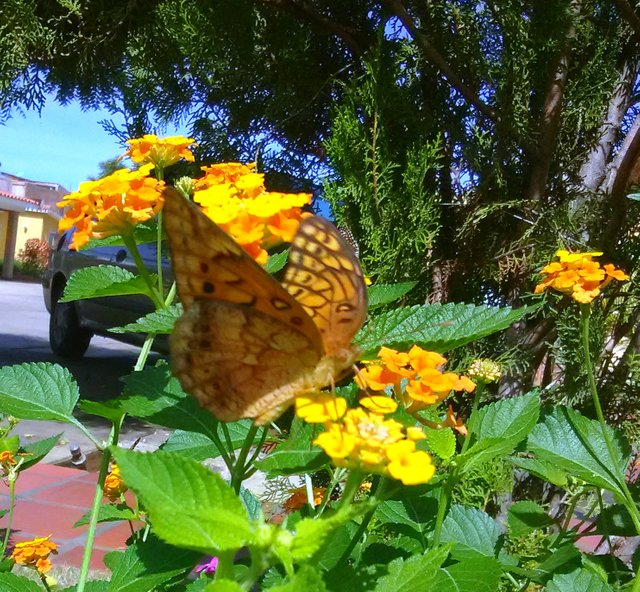How do the butterflies feed?
Surely you've seen fluttering butterflies in a flowered garden and perched briefly on the flowers. We know that these delicate and colorful winged creatures feed on the nectar they find in flowers and other liquid foods.

If we look closely at this precise moment, we will see that butterflies have a kind of elongated tube with which they extract their food. These go perching from flower to flower and absorbing in each its nectar.
Sitting on the lawn of my garden and waiting patiently, I managed to record the usual behavior of a butterfly when feeding. I invite you to see it, dear reader!
As I mentioned, these insects extend their buccal apparatus and introduce it to the flower in search of nectar. Today I will talk about this part of the butterflies, known as Proboscis.
A tube that absorbs liquids
That's right reader friend, located on the head of the butterfly it's found an extensible, flexible and very sensitive buccal structure formed by two hollow tubes together called maxillas, which are responsible for carrying the nectar of flowers or any liquid substance that serves as food into to the esophagus. Its scientific name is Proboscis and when the butterfly finishes feeding it retracts and it coiling under the head of the insect.

(Figure elaborated by @ufv using Microsoft PowerPoint)
The butterfly can introduce its proboscis into flowers to absorb (suck) its nectar, but also has the ability to tilt it allowing it to feed on different angles without having to move, as seen in the following image.

Only liquid foods
Besides the nectar of the flowers, the butterflies also feed on the sap of the trees, juice of ripe fruits, liquids of decomposing materials and excrements of animals and even of the humidity of the soil and the minerals dissolved in it. In the following Youtube video you can appreciate his taste for fruit juice.
Not all species feed
Most species do so, whether they are diurnal or nocturnal. However, there are some nocturnal species that never do so, because they are kept with the energy reserves acquired during their caterpillar stage.
During the winter season, other species enter a state of lethargy to minimize energy consumption and make better use of them, limiting the absorption of food.
Conclusion
The Proboscis is an elongated and tubular organ located in the head of some animals (invertebrates) such as butterflies, whose function is to suck liquid for their feeding. Also, some worms too have it (Nemertea and Annelida) and insects Diptera (these could be topics for future publications).
In vertebrates, the proboscis is known as the trunk of the elephant, South American tapir, the mono proboscis, among others. In these cases, it is an extension of the nose and has the function of respiratory organ, pressure or suction.
At the end of this publication, dear reader, I hope you have learned something new about butterflies and their feeding. The next time you see these insects in your garden "jumping" from flower to flower, remember the way they feed, similar to when we used a straw to take a tasty juice.
Have a happy day!
References
- https://www.asturnatura.com/articulos/lepidopteros-mariposas/formas-vida-alimentacion.php
- https://es.wikipedia.org/wiki/Prob%C3%B3scide
- https://www.amentsoc.org/insects/fact-files/mouthparts.html
- http://www.mariposapedia.com/anatomia-mariposas/
- https://allyouneedisbiology.wordpress.com/tag/proboscide-mariposa/
- https://en.wikipedia.org/wiki/Proboscis
This post has been voted on by the SteemSTEM curation team and voting trail in collaboration with @curie.
If you appreciate the work we are doing then consider voting both projects for witness by selecting stem.witness and curie!
For additional information please join us on the SteemSTEM discord and to get to know the rest of the community!